
At least 2000 bucks.
As Bluetooth true wireless earbuds have shrunk in size and cut the cord between the ears, more and more consumers are wondering when these devices will turn into hearing aids. Both products are starting to look a lot alike, so how soon will these earbuds be able to replace hearing aids that cost thousands of dollars more?
In order to understand where we’re at, it’s useful to compare current Bluetooth earbuds with hearing aids, starting with their hardware, which includes electronic components and physical design, then moving on to functionality, which is largely controlled by software. When possible, specific components are compared side by side to show how current earbuds and hearing aids stack up. The hardware comparison is followed by an exploration of the ability of earbuds to duplicate some fundamental hearing aid operations.
Hardware
The most important goal of the hearing aid hardware industry has always been to make things smaller (Killion, Van Halteren, et al, 2016). In the 50s, body worn devices were the size of a deck of cards (Figure 1).
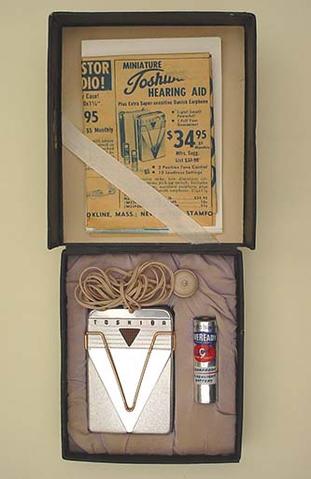
By the 90s, Completely In the Canal (CIC) devices were possible (Figure 2). Presently, an even smaller size is available, Invisible in the Canal (IIC) devices. IICs manage to fit a microphone, speaker and battery into a device that fits deep in the ear canal. This unrelenting drive toward miniaturization has been the dominant force affecting the price and performance of modern hearing aids. The consequences of this will become apparent as we compare hearing aid hardware with the corresponding consumer electronics versions of device components.
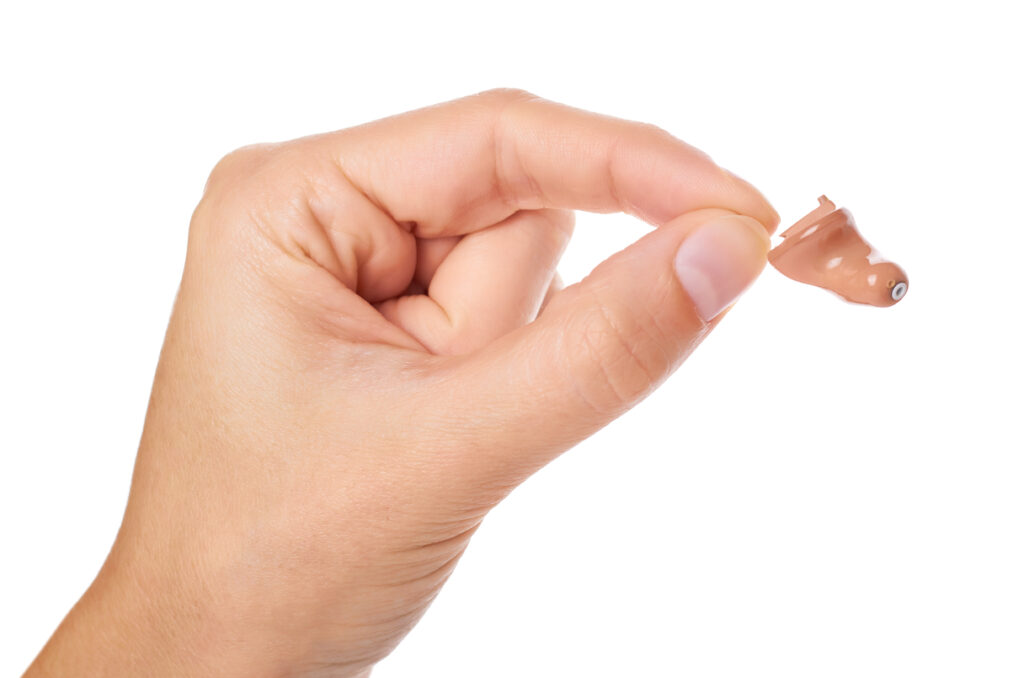
In its simplest form, the building blocks that make up a hearing aid are shown in Figure 3. Earbuds have the same functional blocks, although signals are routed differently when in a phone call or listening to music. Still, it’s no problem to configure an earbud to work like a hearing aid, with an input microphone signal going through the processor, then out to the speaker. Let’s look at examples of each of these components and compare the hearing aid versions with Bluetooth earbud versions.
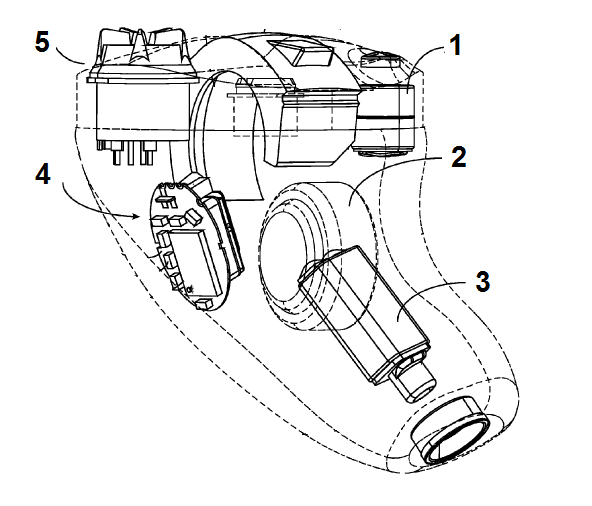
Microphones
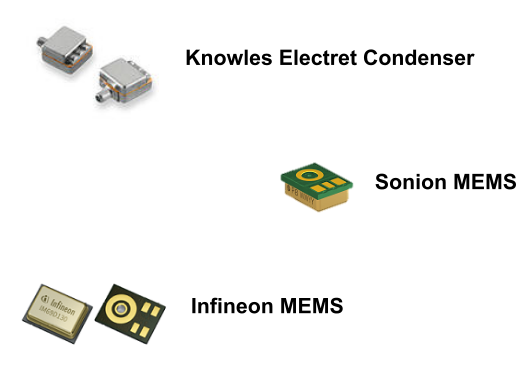
Hearing aids require very quiet, very small microphones, Figure 4. Until recently traditional hearing aid microphones have been based on electret condenser technology. These were easy to miniaturize and the internal noise they generated was engineered to very low levels over the years. Most of these devices have a spout that functions as a sound inlet and 3 solder terminals (power, ground and output). The spout allows tubing to be used to guide the sound from the outside of the device to the microphone. Very small lightweight wires are soldered from the microphone to the hearing aid amplifier.
Over the last decade a new microphone technology has taken over. Microelectromechanical Systems (MEMS) technology has finally reached acceptable levels of noise performance and power consumption to be used in modern hearing aid design. MEMS devices are formed from deposition and etching on silicon chips, similar to microprocessors and other integrated circuits, except tiny mechanical devices are produced. The manufacturing process is very precise and as a result, MEMS microphones match each other in performance very closely. This turns out to be very important for their use in hearing aids.
MEMS devices have a small sound inlet, often enclosed with a circular solder pad, and the power, ground and signal solder pads along an edge. These components are soldered directly to printed circuit boards (PCBs) in an automated assembly process similar to manufacturing any other high volume electronics product. It’s much faster and cheaper than hand soldering the tiny wires on the older electret mics.
Bluetooth earbuds have been using MEMS microphones longer than hearing aids because they could use the earlier generations that were noisier and more power hungry. We’ll compare three types of microphones here, the traditional electret condenser hearing aid microphone (Knowles EM-23346-B04), a hearing aid quality MEMS microphone (Sonion P8AC03) and a state of the art consumer electronics grade MEMS microphone (Infineon IM69D130) that might be found in earbuds like the Apple AirPods Pro.

For comparison we’ll focus on the basics: noise, power consumption and size. The frequency response is flat and extends well past 10kHz for all these mics, so it’s not included in the comparison.

Figure 5 shows the ultra low power consumption of hearing aid microphones compared to consumer grade devices – a difference of well over an order of magnitude. This isn’t a straightforward comparison however, since the Infineon mic has a digital output, which eliminates the need for an analog to digital converter, saving overall system power. The consumer grade Infineon mic can also be run at a lower current, although this raises the noise level. The specs show that consumer grade microphones are now available that are just as quiet as hearing aid microphones, although they’re slightly bigger. If a hearing aid microphone has an EIN in the 20s, it’s quiet. Recording studio microphones are considered noisy if they go above 20 dBA.
Speakers/Receivers
One of the first things to learn about hearing aid components is that the hearing aid ‘speaker’ is referred to as the ‘receiver’. This is a hold over from the early days of telephone technology. Since hearing aid receivers need to be very small, they work a little differently than traditional dynamic loudspeakers. Both drive a diaphragm by passing a current through coils of wire in a magnetic field, but their physical arrangements are different (Figure 6). Hearing aids use ‘balanced armature’ receivers which are very efficient at delivering sound and require less power than traditional dynamic loudspeakers. Many high end earphones also used balanced armature receivers, with many audiophiles preferring their sound over that from small dynamic loudspeakers. To the average listener both speaker and receiver components sound the same. Balanced armature receivers are used in hearing aids because of their miniature size and low power requirements, not because of any special audio properties.

Since Bluetooth earbuds are designed mainly to reproduce music, they cover a wide bandwidth and don’t produce high levels of distortion. Even moderately priced Bluetooth earbuds have speakers that are more than adequate for producing excellent sound for a hearing aid mode.
According to Knowles, a typical dynamic speaker takes 6 times as much power as a balanced armature to produce the same SPL. Overall system power savings would depend on the total power spent running the device. Another Knowles analysis came up with a 17% improvement in battery life when an earpiece used a balanced armature rather than a dynamic speaker.
It’s important to note that balanced armature receivers are designed to work best in a sealed ear canal. The low frequency power (bass response) of the receiver is very weak when the ear canal is open. Dynamic speakers used in earbuds show the same loss of bass in an unsealed condition, but because of their larger size they are able to deliver more low frequency energy. This sealed/unsealed receiver response, discussed in more detail below, turns out to be one of the fundamental differences between earbuds and hearing aids and raises design issues for earbuds with hearing aid functionality.
Processors
In this article the ‘processor’ block is a simplification that covers everything between the microphone and the speaker. A slightly more detailed description involves three basic function blocks – an input signal block, the signal processing unit and an output amplifier stage.
Most modern hearing devices are digital, meaning the sound picked up by the microphone is converted to numerical data which is processed by software inside the device. The software uses digital signal processing (DSP) algorithms to implement audio filters, directional processing, noise reduction, dynamic range compression and feedback cancellation using mathematical operations. These algorithms are ‘just’ math, although possibly very complicated math, that can be performed on all sorts of different hardware. For example, smartphones can easily implement all the industry standard hearing enhancement algorithms by running programs on their general purpose microprocessors. There are several hearing enhancement smartphone apps that demonstrate this, and while some might suffer from poor microphone sound quality or excess delay, these failings aren’t caused by a lack of processing power.
Signal processing hardware follows the pattern we’ve seen established with the other hardware components – hearing aids use very small, specialized, ultra low power modules. Many of the large hearing aid companies use their own proprietary chips. We’ll look at a special purpose DSP processor designed for use in hearing aids, the Ezairo 7160 from ON Semiconductor, and compare this with an example from the most recent Qualcomm chip that’s starting to be used in new Bluetooth earbud designs, the QCC5127. Figure 7 shows some technical specs for both chips. The QCC5127 has a lot of processing power along with integrated system functionality like battery charging. The 7160 features ultra low power and specialized coprocessors designed to handle specific processing tasks used by most hearing aids.

As a basis for comparison, we’ll look at the power required to stream audio, Fig 8. This is an apples and oranges situation because the chips are designed for different applications and it’s difficult to find examples where they run the exact same algorithms. The Qualcomm chip takes about 6x the power of the Ezairo in this example, but it’s not really a fair comparison because the Qualcomm chip is performing more processing at a higher bandwidth. On the other hand, the Ezairo would be able to go much lower than the Qualcomm chip in a more typical hearing aid application with no streaming wireless audio. In this traditional hearing aid mode the Ezairo could approach 1mA at 1.25V, or 1.25mW, which is much lower power consumption than standard consumer electronics chips are designed for – or capable of.
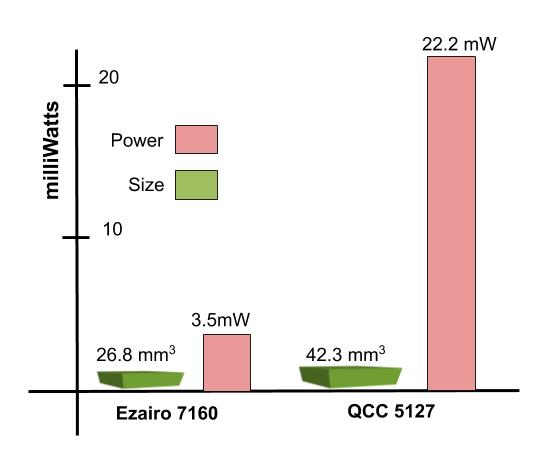
So, although difficult to compare head to head, specialized hearing aid processors still use much less power than consumer electronics processors, but the consumer chips have no problem running state of the art hearing enhancement algorithms and are still considered low power devices.
Battery
Both hearing aids and Bluetooth earbuds use batteries as a power source, but some hearing aids still use disposable batteries while Bluetooth earbuds are all rechargeable. Hearing aid batteries need to be replaced every 5 to 7 days, assuming close to 13 hours a day of use. Earbuds have user friendly charging systems, but most new, smaller styles need to be recharged after 4 to 6 hours of use. Many have cases that function as portable chargers.
Figure 9 shows the comparison between a style of rechargeable battery used in many earbuds like Apple Airpods and a size 312 disposable hearing aid battery. The battery energy capacity is shown in milliwatt hours, mWh. A capacity of 224mWh means the battery can supply 224mW for one hour, or 112mW for 2 hours, etc.

The short battery life of earbuds isn’t close to matching the typical constant use of hearing aids. However, it might be acceptable for a device that’s only used in specific situations throughout the day.
Hearing aid battery technology is slowly converging with rechargeable earbuds. Many manufacturers suggest their rechargeable hearing aids are devices you charge every night, which should then allow you to use them the entire next day. Many have cases that function as portable charging units, like the Airpod and other earbud cases.
Since rechargeable hearing aids are new and users don’t have much experience with them, their popularity might be dampened by unknowns regarding their lifespan and cost of battery replacement. Earbud batteries wear out too, but a $200 device that lasts two or three years is much different than a $2000 device with the same problem. Rechargeable hearing aids have finally arrived though, and all major manufacturers offer a wide selection of rechargeable devices.
Eartips
Both hearing aids and Bluetooth earbuds are worn directly in the user’s ear to transfer sound to the eardrum more effectively. While the device designs are becoming similar in many ways, this is one area where the two types of devices have different goals and are actually moving apart from each other.
Sales of behind-the-ear (BTE) hearing aids tripled from 2000 to 2009 due to the introduction of open-fit hearing aids (Kirkwood, 2009). Users prefer an eartip that doesn’t seal the canal because of something called ‘occlusion’, which is the annoying effect you get if you stick your fingers in your ears then talk (Figure 10). Open fit devices greatly reduce the occlusion effect and are perceived as delivering a more natural sound quality (Winkler, 2016). Not everyone is a candidate for open fit devices, but they are extremely popular.
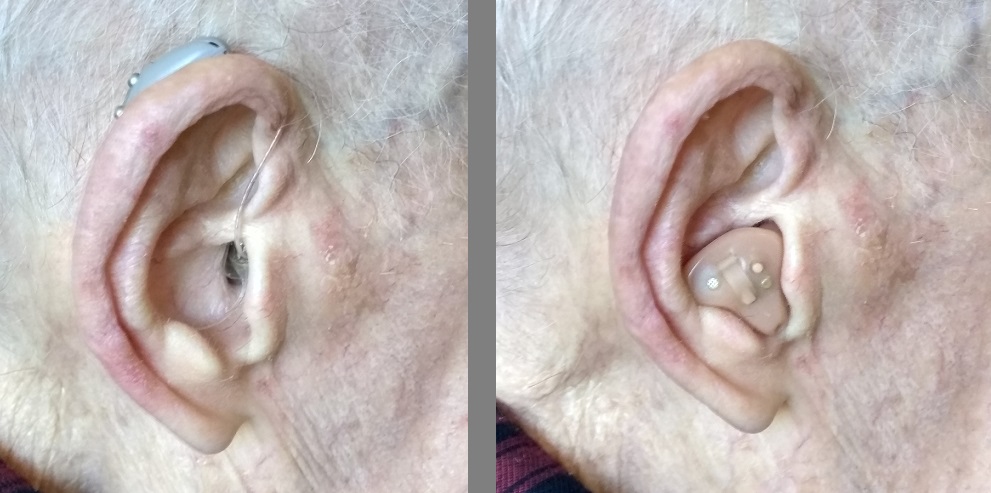
The open fit design uses a very small receiver situated in the ear canal with a dome that allows sound in and out of the ear (Figure 11). It’s very difficult for these devices to deliver low frequency sounds, but this often isn’t a problem for the many people that require hearing compensation primarily for high frequencies. Even the more traditional ITE and ITC hearing aids that sit fully inside the ear have vents that attempt to open the ear canal to reduce occlusion. Decades of research have gone into vent size and design, all to address the very common complaint that a hearing aid that completely seals the ear canal produces annoying artifacts (Kiessling, 2005; Kuk, 2006; Curran, 2012).

Bluetooth earbuds are designed to reproduce music, so low frequency performance is very important, especially for contemporary popular music. The bass response is boosted when the device seals the ear canal. Also, a sealed ear canal is extremely helpful for the reduction of environmental sound through Active Noise Control (ANC), a feature increasingly common on Bluetooth earbuds. Now that the recent Apple Airpods Pro design went to a sealed eartip, virtually all of the top Bluetooth earbuds are onboard with a closed ear canal that keeps environmental sound out and speaker sound in. When a device with this style of sealed eartip is used as a hearing aid, the user’s voice sounds boomy and unnatural.
Sound processing
We’ve covered the physical difference between hearing aids and earbuds, now we’ll look at the signal processing capabilities earbuds would need in order to function as basic hearing aids. A collection of fundamental algorithms is described, each one followed by a determination of whether a typical earbud could carry out the same processing. Higher end hearing aids include additional algorithms along with fancier jargon to describe some of the same basic operations.
Frequency compensation
Hearing loss is a function of frequency. Many people can easily hear the low frequencies that form vowels in speech but have trouble hearing higher frequencies that make up sounds like ‘th’, ‘f’, and ‘s’. The frequency response of the device needs to be adjusted to boost frequencies where the user has trouble hearing. This is accomplished by filters, similar to treble or bass controls on a stereo. Thanks to digital signal processing (DSP), it’s possible to boost and cut the sound at specific frequencies by precise amounts.
Bluetooth earbuds already use filters to tune their sound, especially for music playback. They don’t shape the frequency response to the degree that hearing aids do, but they’re capable of it.
Compression
Compression is the fundamental signal processing algorithm that all modern hearing aids are based on. (This is dynamic range compression, not data compression like an mp3 file.) It can also lead to the most confusion, resulting in hazy explanations of how hearing aids are much more complicated than simple amplifiers and how they provide almost magical compensation for hearing loss.
Imagine you’re watching a movie on TV late at night and you don’t want to wake up everybody in the house, so you have the volume at a low level. This works fine when the actors are yelling at each other and things are blowing up, but when a quiet scene with whispering comes along, you need to turn the volume up. Of course, you have to remember to turn the volume back down when the loud explosions return or you’ll wake everyone up.
So, turn up the soft sounds, turn down the loud sounds – that’s compression. The compression processing usually varies with frequency. The signal is divided into frequency bands and the level of each band is used to adjust its own particular volume. Now you have ‘multi-band compression’. (There are many more details beyond the scope of this article. If you want to see what the real compression aficionados are up to, check out the music recording industry.)
Most Bluetooth earbuds already use some form of dynamic range compression to improve their sound quality and avoid overloading their speakers. It’s not a central part of the sound processing, but there’s no problem running the algorithm on earbud processors.
Directional processing
One of the most effective signal processing techniques to improve hearing aid performance in noise is the use of directional microphones. If the microphones only pick up sound from the forward direction, for example, all the noises and unwanted sounds from behind the user are reduced, which makes listening to someone in front of the user much easier. Many hearing aids form a directional pattern using the signals from two separate microphones inside each device.
Most Bluetooth earbuds use directional processing when in a phone call. In contrast to hearing aids, the goal is to pick up the user’s own voice exclusively. Hearing aids would try to minimize the user’s own voice, if at all possible. These slightly different use cases might result in compromises involving the physical design of devices intended for both phone and hearing aid use.
Noise reduction
Most people are familiar with the idea of noise reduction. The goal is to remove as much background noise as possible while still letting the speech get through. All modern hearing aids run their own version of noise reduction.
Bluetooth earbuds also perform noise reduction, mainly in phone mode, cleaning up the microphone signals.
One interesting point about noise reduction is that it doesn’t really improve people’s ability to understand speech in noise. There have been numerous studies that show this (Hu, 2007; Bentler, 2008; Hilkhuysen, 2012; Brons,2014). It does make it easier to listen to speech in noisy environments and it’s credited with reducing listening effort.
Feedback Reduction
Anyone with a relative that wears hearing aids is familiar with the high pitched squeals hearing aids sometimes give out, usually when they get covered up or aren’t in the ear all the way. These squeaks are caused by the sound coming out of the hearing aid receiver and ‘feeding back’ into its own microphone. The hearing aid industry has been waging a constant battle against feedback since the first devices were built. Significant progress has been made in the current digital era and a lot of research has gone into the state-of-the-art algorithms. The newer open fit hearing aids require high performance feedback cancellation since the path from the receiver output to the microphone input is less obstructed.
When playing music or handling phone calls, Bluetooth earbuds don’t need feedback cancellation like hearing aids. The closest existing earbud algorithms are echo cancellation, in phone mode, and ANC to cancel environmental noise. These algorithms can be as complex as feedback cancellation, and provide evidence that if a hearing aid mode is implemented in an earbud, the processing power is available to run feedback cancellation algorithms.
Fitting
Most hearing aids are customized for individuals by an audiologist who tunes the signal processing parameters so the device works optimally for a particular user’s hearing loss. This is known as ‘fitting’ the devices and it usually involves a trip or two to the audiologist’s office. However, we’re seeing more remote adjustment of hearing aids along with systems that allow the end user to adjust the devices themselves. Fitting can be thought of as a two stage process: 1) measurement of a user’s distinct hearing loss and 2) calculating the best settings for this loss.
Measuring hearing loss
The standard method of measuring hearing loss is through the use of pure tone thresholds. A tone is played at a known level and then its volume is turned up and down, in a specific way, to determine when it can be heard by the test subject. This is done for a set of frequencies, from low to high, and the results are converted into hearing loss as a function of frequency. Hearing loss is expressed as the difference in decibels between the subject and a person with normal hearing (‘normal’ defined by ANSI S3.6-1996). If in order to hear a tone, the subject needs the volume to be 10dB louder than someone with normal hearing, they have a 10dB hearing loss at that frequency. Audiograms show a person’s hearing loss for both ears at different frequencies, Figure 12. The audiogram graph is kind of quirky, with the values on the vertical axis becoming larger in the downward direction, indicating increased hearing loss.
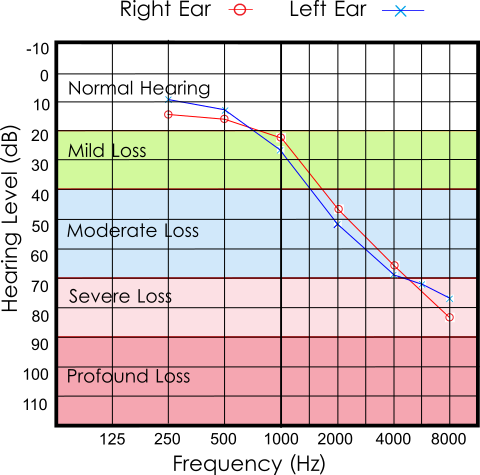
Prescribing parameters
Once hearing loss is measured, signal processing parameters are calculated to compensate for this loss through the use of a ‘fitting formula’. The parameters primarily affect the frequency response and compression described earlier. The customized parameters are stored in the device.
There has been a tremendous amount of research done over the years on fitting formulas used to determine parameter settings based on a given hearing loss. Some fitting formulas are used across the industry, such as NAL-2 and DSL, but in addition, each manufacturer typically has their own formula designed for their specific devices (Smeds, 2015). These should all give the same general settings for frequency gain, but they’re not identical – which is important to realize. There’s not a perfect fitting that makes everything audible. Compression parameters and other settings may vary even more across fitting formulas. In contrast to eyeglasses that rely on lenses shaped precisely for a given prescription to bring things into focus, hearing aids are much less exact and aim for a less defined result.
Could Bluetooth earbuds test hearing?
Bluetooth earbuds could certainly duplicate most of the hearing aid fitting process in the sense that they’re capable of presenting tones at specific levels for a hearing test and they could easily store parameters customized for an individual’s hearing loss. Many earbuds already have companion smartphone apps that could be modified to carry out simple hearing tests that then download customized parameters to devices. The more difficult question is whether the fitting procedure can be made simple enough to be carried out correctly by the average user.
Bottom line: earbuds can match hearing aid performance
In summary, a side by side comparison of components shows that current Bluetooth earbuds are capable of matching hearing aid audio performance. The processors in earbuds are powerful enough to carry out the signal processing needed for modern hearing aid algorithms. Customizing, or fitting, the earbuds is technically possible with the use of smartphone apps.
Differences remain
Earbuds use components that are larger and consume more power than their hearing aid equivalents, so hearing aids will continue to be smaller than earbuds. Most current earbuds last 4 to 5 hours when operating at full functionality, so this is still far from the average hearing aid use case, which is more likely to be constant throughout the day.
The biggest physical difference between these products is the fit of the current devices in the ear. Hearing aids with open fittings have become very popular with users, while earbuds usually seal the canal for better bass frequency performance during music playback and also improved ANC functionality to reduce unwanted environmental sounds. As earbuds are used for longer periods of time and more seriously evaluated as hearing aid alternatives, more users could become aware of the annoyances of a completely blocked ear canal and a larger device on the ear.
Another potentially crucial difference is the professional fitting procedure offered by hearing aids. To replace a trip to the audiologist, earbud companies will need to show that smartphone apps are simple enough for their elderly target demographic to use successfully. Currently, purchasing a hearing aid from an audiologist involves a few hours of one-on-one attention and counselling. Companies proposing earbuds as alternative hearing aids are betting there are customers that don’t need that level of care.
Individual attention costs money, which brings up one of the biggest differences between earbuds and hearing aids – cost. Bluetooth earbuds use consumer electronics components and manufacturing methods, along with a direct to consumer distribution model, bypassing traditional dispensers, resulting in a cost to the consumer that’s an order of magnitude lower than the cost of hearing aids.
Going forward
Bluetooth earbuds are currently able to mimic hearing aid functionality in a number of important ways. It remains to be seen if current earbuds could perform well enough as hearing aids to replace them in significant numbers. The product category is very new and there will undoubtedly be evolution in the product design. The overall result will be increased innovation in the hearing device product space, which is always good for consumers.
References
Brons , I., et al.; “Effects of noise reduction on speech intelligibility, perceived listening effort, and personal preference in hearing-impaired listeners.” Trends in Hearing, Vol.18, Oct. 2014.
Bentler ,R., Wu,Y., Kettel, J., Hurtig, R.; “Digital noise reduction: Outcomes from laboratory and field studies”, International Journal of Audiology, 47:8, 2008.
Curran, J.; “A Forgotten Technique for Resolving the Occlusion Effect”; Innovations: Volume 2, Issue 2, 2012.
Hilkhuysen, G; et al; “Effects of noise suppression on intelligibility: Dependency on signal-to-noise ratios.”; J. Acoust. Soc. Am. 131 (1), January 2012.
Hu,Y, et al; “A comparative intelligibility study of single-microphone noise reduction algorithms”; J. Acoust. Soc. Am. 122 3, September 2007.
Infineon IM69D130 datasheet.
Kiessling, J., Brenner, B., et al; “Occlusion Effect of Earmolds with Different Venting Systems”; J Am Acad Audiol 16:237–249, 2005.
Killion, Mead & Halteren, Aart & Stenfelt, Stefan & Warren, Daniel. (2016). Hearing Aid Transducers 10.1007/978-3-319-33036-5_3.
Kirkwood , D. H.; “Resilient hearing aid industry records rising sales despite a troubled economy”; TheHearing Journal: December 2009 – Volume 62 – Issue 12
Knowles EM-23346-B04 datasheet.
Kuk, F., Keenan, D.; “How Do Vents Affect Hearing Aid Performance?”; Hearing Review February 2006.
ON Semiconductor Ezairo 7160 datasheet.
Qualcomm QCC 5127 product brief.
Sonion P8AC03 datasheet.
Smeds,K; Dahlquist, M; et al; “A look at how NAL, DSL, and proprietary first-fit algorithms have changed since 1998”; Hearing Review, May 2015.
Winkler ,A., Latzel,M., and Holube, I.; “Open Versus Closed Hearing-Aid Fittings: A Literature Review of Both Fitting Approaches”; Trends in Hearing 2016 Jan-Dec;
Good information!
I’m interested in further posts from you.
I am 88 and have never used hearing aids. but have noted dificulkty in hearing clearly on TV or in discussion with people.
Would earphones serve the purpose or are earphones better. What are the advantages of each/?
Thanks.
Jim Edge